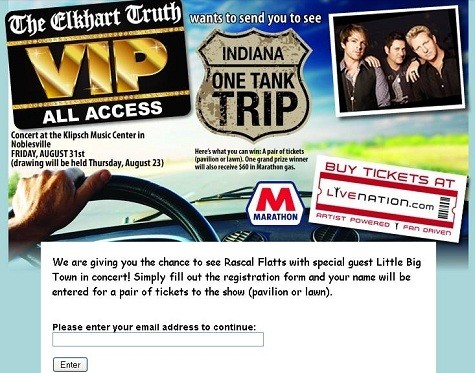Sales of targeted e-blasts at the Elkhart Truth top $40,000
Some advertisers turned away by popular program, proving the value of data
Company: The Elkhart (IN) Truth, a 30,000-circulation daily newspaper
Market: The “RV capital” of the U.S., the paper’s DMA includes Elkhart and South Bend, population just under 200,000
Initiative: Sales of e-mail marketing campaigns
Key Executives: Andrew Walker, Sales Manager and Allison Kusick, Circulation Marketing Manager
Summary: In 2010, the publisher’s marketing department began actively acquiring email data from all of its sources including subscriptions, online registrations and contests. One goal was to create a sideline email marketing sales initiative. Today local advertisers pay a premium for the Elkhart Truth to send merchant-branded e-blasts to highly targeted audiences. The popular upsell is typically sold in annual contracts and is projected to total $42,000 in new revenues for 2012.
Challenge: In a DMA that has suffered great economic difficulties and unemployment as high as 25 to 30 percent since 2007, the Elkhart Truth has been working hard to build its digital future. The executive team understood the importance of acquiring audience data; including the ability to create immediate and high margin incremental revenues from highly targeted eblasts.
Strategy: The formula for selling e-basts relies on four tactics: a. Building a large database, b. Creating numerous targeted opt-ins, c. Pricing and packaging and d. Developing demographics for email audiences and e. Policing programs to guard the value and integrity of the lists.
a. Building the opt-in email lists
An existing subscription audience gave The Truth a head start in buildng its home grown e-mail list. After cleaning the list and merging it with other company lists, the Truth created a schedule of promotions that included 17 online contest and sweepstake entries in the first eight months of 2012. They added email opt-ins to all new subscription forms, and to create highly specific targets, the marketing department added opt-in "VIP Newsletter" choices to all of its online registration forms. In total there are 21 commercial opt-in categories listed in check boxes on the form, and integrated with its email partner, Presslaff:

To acquire demographic informaiotn, the marketing department created online surveys for people who entered online contests. For example, when LiveNation brought five concerts to the area, ticket giveaways required the entrants response to a series of survey questions to complete the form:

Surveys ask questions about consumption habits such as grocery and clothes shopping and days most often shopped. Each survey typically also provides information on age, gender, interests and income, so that as advertisers seek to narrowly target e-mail campaigns, The Truth has the data on-hand.
Pricing and packaging
While still studying the right pricing, The Truth's marketers started by a pricing e-blasts slightly higher than competitors' which don't have the same quality of opt-ins. The fee begins at $12 CPM, with an additional $5 CPM for each additional target specification.
“Our list differs from our competitors' in that it is a solely homegrown opt-in,” said Walker. “If you want...a three-mile radius around your store it would be $12. If you want to narrow it down to females with income of $75,000 or more that would add another $5 CPM. Our small businesses are taking full advantage of that. This list would probably be about 10,000-15,000 email addresses. Or they might just ask to reach six zip codes, and that might be 15,000 to 20,000 email addresses."
Sales organization
One sales team sells both print and multi-media products, including e-mail which is now a standard upsell.
“I know that a lot of papers have very definite lines between departments, but we’re a little different here,” Walker said.
"It was a slower transition initially because people sell what they’re comfortable selling. But we found that the quickest way to get sales reps to sell new products was by bundling and packaging them with traditional ad products and services they’ve always sold. When we started packaging they gained confidence.”
Part of the pitch selling the e-blast with print is that the combined offer reaches 60 percent penetration of the local DMA.
“No local media competitor is offering near that penetration,” said Walker. “Our sales process is sitting down with the customer to find out what his or her needs are. Does print makes sense? Is digital more what they need? We do sell email blasts exclusively if it makes sense.”
To co-brand or not to co-brand
While the initial strategy was to co-brand the e-newsletters with merchant customers, The Truth soon learned open rates were higher if the offer came from the merchant.
“When we first got the PressLaff delivery system, our advisors said that we needed to put “Special offer brought to you by The Elkhart Truth in the email subject line,” Walker said.” They also told us to put a banner across the top of each email that said ‘This savings brought to you by The Truth.’ “
Open rates, however, were low. When The Truth experimented by changing the subject line to represent the advertiser, some open rates shot up to 20 percent, especially on the targeted e-blasts.
“It seemed more relevant to (the audience),” said Walker.”Now we have made the (e-blast) look like it’s coming from the advertiser... though at the bottom it does say 'Brought to you by The Elkhart Truth', and there’s an opt-out... as well.”
The Truth still does not allow advertisers to see or rent the list, protecting its opt-ins from being spammed and its database from being poached. Offers are also vetted to make sure they are valuable. Here is an example of a typical emailed offer:

With so many requests to send marketing blasts to the same email addresses, The Truth must assure that each offer is quality, much like a daily deal list.
“We know we can send an email to the same opted-in subscribers more than once or twice a month, but still we’re in the learning phase of email blasts – we really don’t know how often to hit a list,” Walker said.
“But we respect the fact that customers opted-in to receive savings and special offers. So, we have three people that look at these blasts, asking themselves, ‘Would I think that is a good deal?’ If it doesn’t meet those criteria we don’t send it out. There have to be people within the organization who are guarding that list because without it you have nothing to sell.”
“We saw people opt out of Daily Deals if it wasn’t a good deal,” he said. “So, for e-mail marketing we have said no to a couple of advertisers who didn’t have strong offers, and instead offered them a banner ad for one of our own 6 a.m. e-mail blasts.”
An example of the morning newsblasts is here:

Results
• Based on an average of 3 blasts per week, at $275 each, the Truth is tracking $43,000 incremental revenues per year.
• Most advertisers who purchase the email campaigns commit to 12 month contracts, an advertising commitment atypical of most other products.
•Emails open rates are typically in the range of 7 to 15 percent, depending on the offer.
• The initiative has opened up new categories for a newspaper such as restaurants – which have not traditionally been a big category, Walker said. “The local Fireside Buffet offered a $20 value – buy one get one free – and it sold out. The restaurant had no seats available the first day that ran."
• The program is often sold out, and some deals that are not good enough are turned away.
Lessons learned
• The Truth’s was able to convert and grow about half the original list into an opt-in list. That is, of about 77,000 email addresses , progams converted 41,000 to targeted opt-ins after going through a verification process that also eliminated duplication. From there, the company continues to build the opt-ins the lists via sweepstakes, contests and registrations. Total general emails remains at about 78,000.
•Not every offer that every advertiser wished to promote via email was an attractive enough deal for the target audience.Those that weren’t had to be declined by the publisher, to prevent subscribers from opting out.
•Restaurants did very well with offers to discount meals.
•To protect the list, advertisers do not get to see the email list – they simply order the market they need, and rely on the publisher to send it out.
•Co-branding subject lines have lower open rates and co-branded offers had lower click through rates for very targeted lists. Email with branding and subject line is specific to the advertiser did best.
•Monday is the most responsive day for an email blast.
•For small / mom and pop merchants, a three-mile radius is optimum for email blasts.
•While the Truth is still experimenting with the right frequency, they have found that people will definitely accept an email more than once or twice a month if the advertiser is giving them what they want – a good deal in their particular areas of interest.
Thanks to Allison Cusick and Andrew Walker for sharing their insights. Reach Cusick at 574-296-5909, ACusick@eTruth.com. Walker’s contact is 574-296-5913, AWalker@eTruth.com.

The author, Alisa Cromer is publisher of a variety of online media, including LocalMediaInsider and MediaExecsTech, developed while on a fellowship with the Reynolds Journalism Institute and which has evolved into a leading marketing company for media technology start-ups. In 2017 she founded Worldstir.com, an online magazine, to showcases perspectives from around the world on new topic each month, translated from and to the top five languages in the world.






